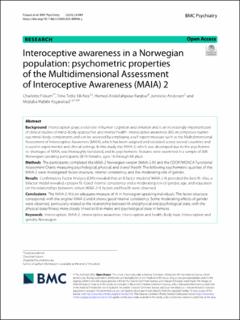| dc.contributor.author | Fiskum, Charlotte | |
| dc.contributor.author | Tetlie Eik-Nes, Trine | |
| dc.contributor.author | Ranjbar, Hamed Abdollahpour | |
| dc.contributor.author | Andersen, Jannicke | |
| dc.contributor.author | Habibi Asgarabad, Mojtaba | |
| dc.date.accessioned | 2023-11-03T09:25:07Z | |
| dc.date.available | 2023-11-03T09:25:07Z | |
| dc.date.created | 2023-07-12T14:28:27Z | |
| dc.date.issued | 2023 | |
| dc.identifier.citation | BMC Psychiatry. 2023, 23 (489), . | en_US |
| dc.identifier.issn | 1471-244X | |
| dc.identifier.uri | https://hdl.handle.net/11250/3100440 | |
| dc.description.abstract | Background
Interoception plays a vital role in human cognition and emotion and is an increasingly important part of clinical studies of mind–body approaches and mental health. Interoceptive awareness (IA) encompasses numerous mind–body components and can be assessed by employing a self-report measure such as the Multidimensional Assessment of Interoceptive Awareness (MAIA), which has been adapted and validated across several countries and is used in experimental and clinical settings. In this study, the MAIA-2, which was developed due to the psychometric shortages of MAIA, was thoroughly translated, and its psychometric features were examined in a sample of 306 Norwegian-speaking participants (81% females, ages 16 through 66 plus).
Methods
The participants completed the MAIA-2 Norwegian version (MAIA-2-N) and the COOP/WONCA Functional Assessment Charts measuring psychological, physical, and overall health. The following psychometric qualities of the MAIA-2 were investigated: factor structure, internal consistency, and the moderating role of gender.
Results
Confirmatory Factor Analysis (CFA) revealed that an 8-factor model of MAIA-2-N provided the best fit. Also, a bifactor model revealed a proper fit. Good internal consistency and a moderating role of gender, age, and education on the relationships between certain MAIA-2-N factors and health were observed.
Conclusions
The MAIA-2-N is an adequate measure of IA in Norwegian-speaking individuals. The factor-structure corresponds with the original MAIA-2 and it shows good internal consistency. Some moderating effects of gender were observed, particularly related to the relationship between IA and physical and psychological state, with the physical state/fitness more closely linked to IA in males and psychological state in females. | en_US |
| dc.language.iso | eng | en_US |
| dc.publisher | BMC | en_US |
| dc.rights | Navngivelse 4.0 Internasjonal | * |
| dc.rights.uri | http://creativecommons.org/licenses/by/4.0/deed.no | * |
| dc.title | Interoceptive awareness in a Norwegian population: psychometric properties of the Multidimensional Assessment of Interoceptive Awareness (MAIA) 2 | en_US |
| dc.title.alternative | Interoceptive awareness in a Norwegian population: psychometric properties of the Multidimensional Assessment of Interoceptive Awareness (MAIA) 2 | en_US |
| dc.type | Peer reviewed | en_US |
| dc.type | Journal article | en_US |
| dc.description.version | publishedVersion | en_US |
| dc.source.pagenumber | 18 | en_US |
| dc.source.volume | 23 | en_US |
| dc.source.journal | BMC Psychiatry | en_US |
| dc.source.issue | 489 | en_US |
| dc.identifier.doi | 10.1186/s12888-023-04946-y | |
| dc.identifier.cristin | 2162151 | |
| cristin.ispublished | true | |
| cristin.fulltext | original | |
| cristin.qualitycode | 2 | |

